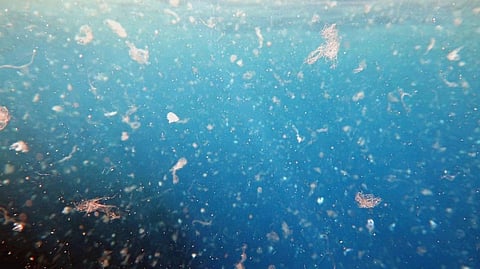Plastic is now in humanity’s blood
According to a study done by Utah State University and Cornell University in the United States (US), the number of airborne plastics or microplastics has surged drastically in the last 50 years and these plastic particles are now spiraling around the globe.
The results of this study showed roads (84 per cent), the ocean (11 per cent) and agricultural soil dust (5 per cent) as the sources of airborne plastic. However, oceans showed the highest concentration of microplastics.
Microplastics present in the sea are expelled as crashing waves cause trapped air bubbles to rise to the surface and burst. This causes microplastics to remain suspended in the air above the surface and then be transported by the atmosphere. This process is known as the ‘surface and bubble burst ejection’ process.
According to another study conducted by the University of Strathclyde in the United Kingdom (UK), this has been considered a potential cause for the atmospheric circulation of microplastics.
Since microplastics are not biodegradable, they tend to persist in the atmosphere, lithosphere and biosphere, forming what is now known as a ‘global plastic cycle’. It has been claimed that this emerging cycle is responsible for the planet’s ‘plastification.’
How? Microplastics are evidently common today, with their distribution ranging from the world’s most densely populated countries, such as China and India, to developed nations, such as the US the UK and even to the most remote regions, such as Antarctica and the Arctic. The Utah / Cornell study has identified the western US, India, Europe, East and West Asia as the hotspots for microplastic pollution.
Researchers are now discovering microplastics everywhere they look — in rivers, the deepest lakes and soils around the world — with microplastics raining on city dwellers, distant mountaintops and even pristine places such as the French portion of the Pyrenees mountains.
The sources of microplastics are varied from the clothes we wear, the cars we drive, to marine activities like fishing, diving, cruising and even traveling. Since plastic is used in the making of everyday products, it is important to reduce our use of single-use plastic or any grade plastic products in our daily lives.
The impact and implications of microplastics on the health of the planet and its inhabitants is insurmountable. These airborne plastics not only have the capacity to cross continental borders but can also reach our bloodstreams.
They are even found in the guts of insects found in Antarctica from sources such as the air we breathe, the water we drink, the food we eat, or the clothes we wear. However, more research is needed to determine the possible health effects of inhaling plastics from the air, food, or water.
According to a study based on calculations of how many microplastic particles people eat in a year, adults consume over 50,000 microplastic particles per year, while children consume about 40,000.
Another study that assessed the presence of microplastics in water estimated that a person who only drank bottled water would consume 130,000 particles per year from that source alone compared with 4,000 from tap water. Still, additional research is needed to fill in the data gaps, as most foods and drinks have yet to be tested.
Microplastics are evidently everywhere now and their influence is affecting not just people’ s lives but also the environment. They may have negative or unknown consequences on both human health and the natural environment, according to a recent study done by Cornell University.
Additional research is urgently needed, at least in countries like India where microplastics are less studied despite being a major hotspot for the same.
Besides extensive research, policies, or technologies, it is now a global environmental concern that demands an individual or personal effort in restricting the use of plastics. This is to be done by avoiding products that include microbeads, choosing clothes made of natural fibres, avoiding single-use plastic products and not littering or flushing plastic waste down the drain.

